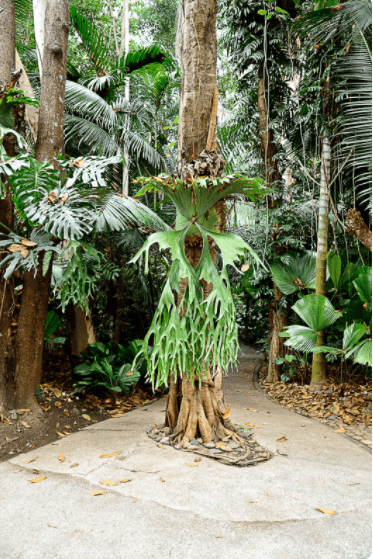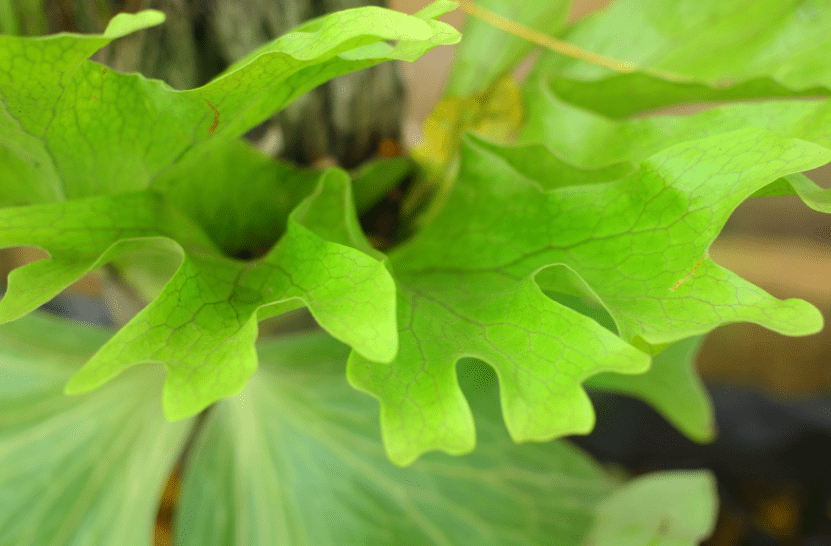Staghorn Fern Information
There’s something oddly appealing about a staghorn fern. Unlike other ferns that delicately creep across a forest floor, the staghorn is big, bulky, and usually grows above eye level in the fork of a tree or suspended in the air.
Its large, antler-like leaves (hence the name staghorn) and brown, helmet-like base are unlike other plants. And few plants say you’re an experienced green-thumber like a mature staghorn in your garden or on your patio.
Don’t be fooled by their exotic appearance — they’re relatively easy to grow. They’re not a lot of work after they become established.
And they can become reasonably self-sufficient within a year or two.
Staghorn Fern Tips
Chances are, the staghorn you bring home from a garden center is growing in a small plastic pot and may be too small to transplant onto a tree or wooden plank, so your priority is to let it grow bigger.
Please place it in bright or filtered light, preferably outdoors but not somewhere where it will get a lot of sun, and make sure it doesn’t dry out completely.
You can let them get dry, but you don’t want them to stay dry very long.
Once the staghorn’s base grows to at least 4 inches across, it is mature enough to start a new life mounted on a board or placed in a tree or a wooden hanging basket. But it’s still too young to be ignored.
Staghorn Fern Growing Tips
To grow it on a board or a tree, we recommend placing wet sphagnum moss around the plant’s root ball and anchoring it to a board with a fishing line or a thin wire, preferably plastic- coasted. (If you want to add a tad more soil around the root ball before covering it with the sphagnum moss, use equal parts potting soil and orchid mix.)
Note: Use a fishing line when tying the plant to a tree because it will stretch as the tree grows and eventually disintegrate. Metal wire wrapped around a tree limb will ultimately cut into the tree.

Once again, make sure the plant doesn’t dry out at any time because the plant base is not large enough to retain water for an extended period.
The critical part is when you’re making that transition from the pot to the board or the tree — you need to give them a lot of care so they don’t dry out completely.
I recommend watering it once a week during the warmer months if it doesn’t rain and once every two weeks through the cooler months.
Fertilizing it regularly will help it grow faster. Also, spray the plant’s base with a liquid solution of 20-20-20 fertilizer or fish emulsion (which can be smelly) or alternate them. Fertilizing it more than once a month in the warm months or once every two months in the winter isn’t necessary.
Staghorn Fern Propagating
The staghorn will produce two types of fronds: fertile fronds, which are the green “antlers,” and shield fronds, which turn brown at the base.
As its base grows, it will continue to become more established and require less care because it can retain more water on its own inside its base. Older shield fronds inside the ground will regularly decompose and provide more nutrients as the plant gets bigger.
Established staghorns need water only about once every two weeks if they don’t receive rain.
Staghorn Fern Pests
The most common pest to affect staghorns is scale. If the little brown or white scales are caught early, they can be killed with a cotton swab dipped in rubbing alcohol. More extensive scale can be treated with the pesticide Cygon.
What staghorn fern may lack in sheer beauty, it makes up for by being easy to grow. A dunking in water every two or three weeks is sufficient in winter.
In summer, hang the fern outside in the shade, and occasionally water and fertilize. Staghorn ferns enjoy acidic soils, growing best when fertilized with acidic fertilizers and watered with acidic water. (A half-teaspoon of vinegar will sufficiently acidify a quart of alkaline water.)
Most species of staghorn fern are native to lush, tropical jungles. The common staghorn fern tolerates better indoor conditions and cool temperatures than the other species. Elk’s-horn fern is suitable for growing in pots because its fronds remain upright.
The largest species of staghorn fern grows fertile fronds as large as 6 feet long. Just picture this plant growing in some tropical jungle in the fork of a tree, bathing in a steamy low mist and nestled among lush greenery.
Staghorn ferns have been described as “noble, antlered plants,” Some genuinely live up to this description.
Indoors, staghorn fern will never achieve such majestic proportions. Still, it can become increasingly noble as it grows new offshoots and envelops its tree-fern mount.
Plant Details
Scientific name: Platycerium species.
Growth habit: An evergreen perennial foliage plant producing clusters of individual plants, each growing to 3 feet tall and wide. The leaves are medium green and consist of sterile fronds that grow flat to enclose the growing medium and fertile spore-producing fronds that extend outward and are lobed, growing to 3 feet long.
Light: Display in shady to filtered-sun locations.
Water needs: Drought tolerant; grows best with waterings twice a week during the hot, dry months.
Feedings: Feed monthly March through October with a 20-20-20 or similar fertilizer solution mixed at half the label rate.
Propagation: Start plants by removing offshoots, called “pups,” to transplant to pots, baskets, or slabs of bark.
Ease of culture: Easy.
Hardiness: Tender; survives temperatures to freezing.
Major problems: Scale insects and leaf spots may affect the foliage—control by removing severely affected fronds or applying natural pesticides. Gardeners often produce plants that grow too big for their landscapes, making care and cold protection difficult. Most can be divided before they get too large and shared with friends.
Pruning: Remove declining fertile fronds as needed to keep the plants attractive.
Uses: Staghorn ferns add the exotic look to local landscapes when hung from the limbs of trees, under arbors, and at the eaves of homes.
The plants grow large in time; it usually takes strong support to hold older specimens. Smaller plants can also be displayed in the home, on porches, and atriums.
























